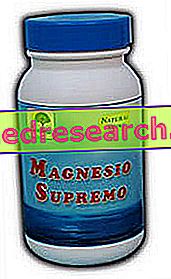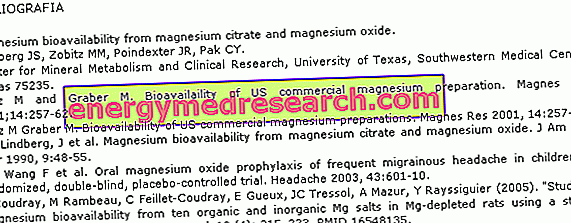What is Supreme Magnesium?
Magnesium Supremo ® is the registered name of a food supplement based on magnesium carbonate and citric acid.

Ingredients
According to the manufacturer's declared label, supreme magnesium contains:
Acidifier: citric acid, magnesium carbonate.
In the product, therefore, we do not directly find magnesium citrate, but magnesium carbonate (MgCO 3 ) and citric acid (C 6 H 8 O 7 ), which in contact with water react to originate magnesium citrate and release carbon dioxide (which gives the typical effervescence).
Mode of Use
The manufacturer recommends dissolving a teaspoon of Magnesium Supremo® in hot water, one to two times a day. Wait for the drink to become transparent before drinking.
According to the manufacturer, the suggested daily dose (two teaspoons) provides 430mg of elemental magnesium, equal to 114.6% of the Reference Nutritive Values for an adult person, according to what established by the reg. EU 1169/2011.
Are there any advantages?
Magnesium citrate is one of the many forms (magnesium salts) under which this precious mineral is marketed in a dietetic and pharmaceutical environment.
Among the most used magnesium salts, we also remember:
- magnesium carbonate,
- magnesium oxide,
- magnesium sulfate,
- vegetable magnesium,
- magnesium pidolate,
- magnesium aspartate,
- magnesium lactate,
- magnesium glycinate,
- magnesium diglycated,
- magnesium chloride,
- magnesium succinate,
- magnesium taurinate.
Each of these salts has specific characteristics in terms of cost, physicochemical perculiarity, bioavailability and use profile.
Beyond the cost, those who intend to take a magnesium supplement should pay attention above all to two characteristics:
- percentage of elemental magnesium: gives an indication of the actual magnesium content in the product;
- bioavailability: gives an indication of the percentage of magnesium actually absorbed in relation to the dose taken.
Elemental Magnesium
Magnesium oxide (MgO) is the salt richest in elemental magnesium: around 60% by weight of the molecule is in fact represented by magnesium, while the remaining 40% is represented by oxygen.
Deepening, how to calculate the percentage of elemental magnesium.
With the help of a periodic table we recover the atomic weights of oxygen (16u) and Magnesium (24.3u). It follows that a molecule of magnesium oxide weighs (has a molecular mass of) 40.3u; making the proportion (24.3 / 40.3) * 100 we discover that the percentage of elemental magnesium in the magnesium oxide molecule is equal to 60.3%.
Magnesium sulfate contains only 10% of elemental magnesium (so 1 gram of magnesium per 10 grams of product), while magnesium citrate has slightly higher percentages (16%).
| Magnesium ion content in various magnesium compounds (hydrates) | |
| Magnesium salt | Grams of magnesium per gram of the compound |
| Magnesium Oxide | 0.600 g |
| Magnesium Citrate | 0.160 g |
| Magnesium chloride | 0.120 g |
| Magnesium Lactate | 0.120 g |
| Magnesium Pyruvate | 0.100 g |
| Magnesium Sulphate | 0.100 g |
| Magnesium Pidolate | 0.087 g |
| Magnesium Orotate | 0.077 g |
| Magnesium Gluconate | 0.058 g |
NOTE: in magnesium citrate, the percentage of elemental magnesium depends on the ratio between the magnesium molecules and those of the citrate; in the various products, this salt can in fact be found in a proportion of 1: 1 (in this case contains about 11.3% of elemental magnesium) or in a proportion of 3: 2 (in this case it contains about 16.2% of elemental magnesium) .
In addition to being less rich in elemental magnesium, the 1: 1 product also has a lower alkalizing potential, while it is more soluble in water.
Bioavailability
Beyond the percentage of elemental magnesium, it is very important to also evaluate the bioavailability of the magnesium salt used for dietary supplementation.
Magnesium oxide, although very rich in elemental magnesium, is very little bioavailable; means that it is absorbed by the intestine only minimally. Not surprisingly, magnesium oxide - better known as magnesia - is often used as a laxative; being scarcely soluble in water and not very absorbable, it tends to draw water into the intestinal lumen, softening the feces to make them watery.
In general, the organic forms of magnesium - such as magnesium lactate, magnesium citrate, magnesium succinate, magnesium aspartate, magnesium glycinate, magnesium taurinate etc. - they are more bioavailable than inorganic forms (magnesium chloride, magnesium carbonate, magnesium oxide, magnesium sulfate, etc.), reaching absorption rates 2-3 times higher.
The bioavailability of magnesium chloride is however discrete, thanks to its remarkable solubility in water.
Unfortunately, in the literature there are rather contrasting data regarding the absorption percentages of the various magnesium salts, and therefore it is not possible to provide more specific and detailed information.
According to some studies, only 4% of magnesium taken in the form of magnesium oxide would actually be absorbed, while for organic salts the percentages absorbed would be 2-3 times greater, in the order of 8-12%.
NOTE: as regards the percentages of absorption of food magnesium, textbooks propose percentages varying from 10 to 50%. For more information, see the article on magnesium absorption.
We can however state that there is no scientific evidence to attribute to magnesium citrate any superiority in terms of pharmacokinetic properties and clinical efficacy. In fact, there is no supremacy regarding bioavailability and therapeutic effects compared to the other organic salts mentioned in the article.
Let us remember for the sake of completeness that magnesium is better absorbed on an empty stomach and that it also performs an important laxative action, so that at appropriate dosages it is used to clean the intestinal walls during preparation for surgery or colonoscopy.
The choice of the magnesium form best suited to one's needs is therefore strictly subjective; for most people, for example, magnesium chloride is a rather cheap source and has a fair bioavailability.
Side effects
Magnesium citrate intake has generally proved to be well tolerated and free of any particular side effects.
Only in rare cases, limited to overdosage or hypersensitivity to the product, may appear digestive disorders, nausea, abdominal pain, diarrhea and allergic reactions, including dermatological ones.
In healthy people, any excess magnesium taken through diet or supplements, such as supreme magnesium ®, is excreted in feces, urine and sweat, without creating particular problems.
When renal function is compromised, the intake of supreme magnesium ®, other magnesium supplements or antacids based on magnesium salts, increases the risk of hypermagnesaemia, with the consequent appearance of arrhythmias, respiratory depression and alterations of neuromuscular transmission . The supplement is generally contraindicated, or is conducted under medical supervision, in patients with heart disease, haemolytic anemia, hypothyroidism, hyperparathyroidism and diabetes not adequately controlled by drug therapy.
Before embarking on the integration with Magnesium it is therefore necessary to make sure that the subject's renal and cardiac functions are not compromised.
As a precautionary measure, for food supplements the health ministry imposes a maximum daily magnesium intake of 450mg; a limit slightly higher than the dosage recommended on the label for the supplement that is the subject of this article (equal to 430mg).
It is therefore advisable to avoid exceeding the intake doses suggested in the Magnesium Supreme ® label.




